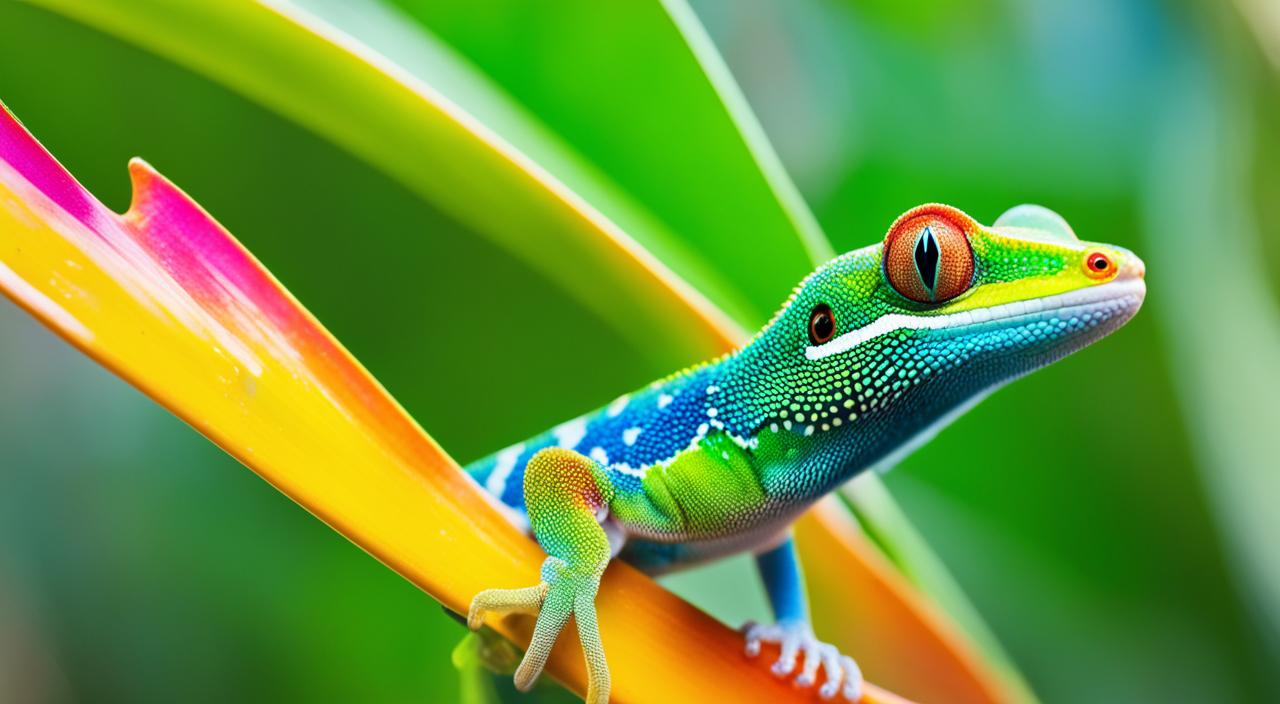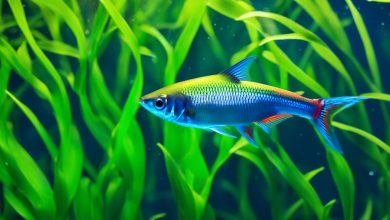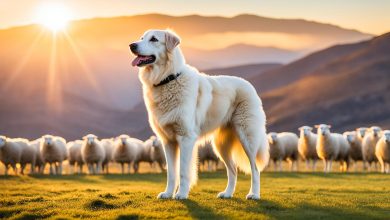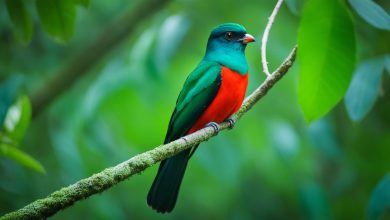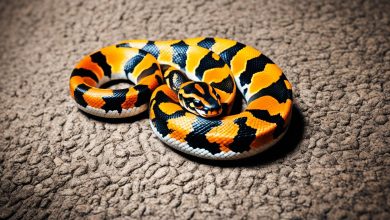The gold dust day gecko (Phelsuma laticauda) is a favorite among reptile lovers. It comes from northern Madagascar, the Comoro Islands, and the Mascarene Islands. Now, it also lives in Hawaii and other Pacific places. Its bright green or yellowish-green body with red speckles is a sight to see.
Gold dust day geckos love to live in trees and eat insects, soft fruits, and nectar. They are not just beautiful but can live up to 15 years with the right care.
Introduction to the Gold Dust Day Gecko
Origin and Distribution
The gold dust day gecko, known as Phelsuma laticauda, belongs to the Phelsuma genus. This group includes several species of day geckos found mainly in Madagascar and nearby islands. They are native to the northwest of Madagascar, the Comoro Islands, and the Mascarene Islands.
They have also been introduced to Hawaii and other Pacific islands with tropical climates.
Physical Description
Adult gold dust day geckos can grow to about 4.5-6 inches (11-15 cm) long. They have a bright green or yellowish-green base color. Their necks, backs, and tails are covered in red speckles and markings.
They have a sharply tapered snout, round lidless eyes, and sticky toe pads. Their tails are slightly flattened, and their skin is delicate and velvety. Young Phelsuma laticauda lack the bright red color, showing a more muted look until they grow up.
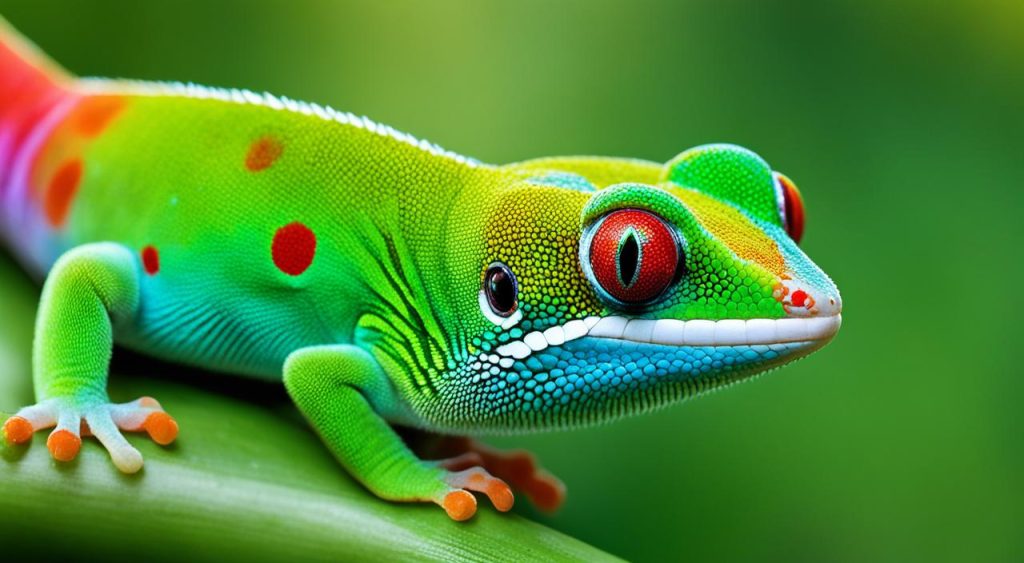
These geckos are popular pets because of their stunning colors, low price, and resilience. They are often sold by specialty retailers like Josh’s Frogs, starting at 4 weeks old. In captivity, they can live up to 10 years, making great companions for their owners.
The Gold Dust Day Gecko in Nature
Habitat and Behavior
The gold dust day gecko lives in the tropical forests of northwestern Madagascar. These lizards love to stay high up in the trees and among the leaves. They are great at climbing and moving quickly through the branches.
Gold dust day geckos are active during the day, enjoying the sun and hunting for food. They can be territorial and aggressive, especially the males. They often fight to be the top one in their group.
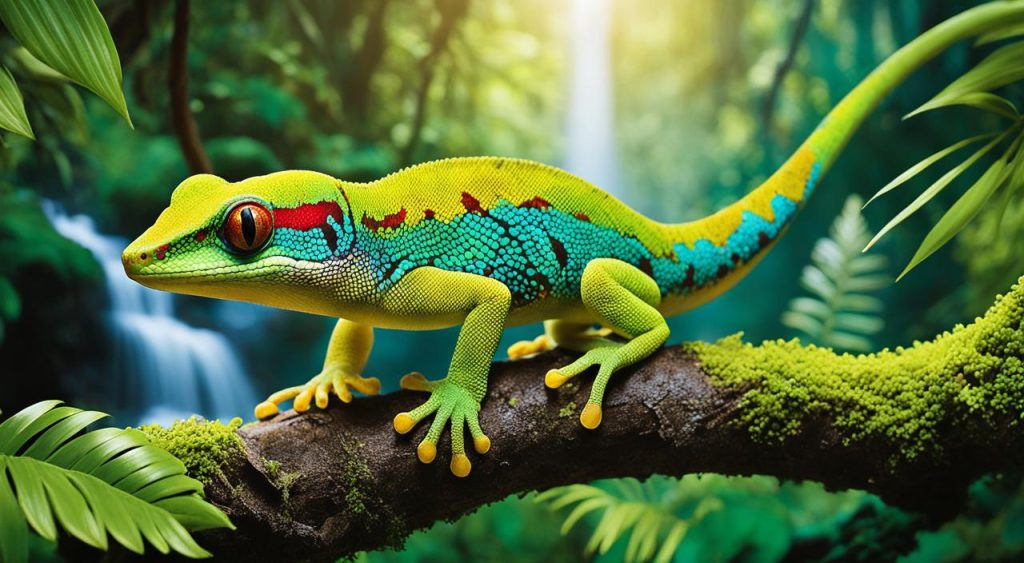
These geckos can live up to 10 years in the wild or in captivity. They become adults between six and 12 months old. You can find them in Madagascar and also in Hawaii, where they were brought illegally in the 1970s.
Captive Care for the Gold Dust Day Gecko
Creating the right home is key for the gold dust day gecko‘s health. They need a big, front-opening gold dust day gecko terrarium that feels like their natural home.
Enclosure Requirements
A single gold dust day gecko should have at least a 12″L x 12″W x 18″H (30 x 30 x 45 cm) enclosure. It should be filled with live plants, vines, and branches. This makes an arboreal gecko habitat perfect for climbing.
Lighting and Temperature
Gold dust day geckos are active during the day. They need UVB light and a warm spot of about 90°F (32°C). The main area should be between 82-89°F (28-32°C), dropping to 70-77°F (21-25°C at night). Good lighting and temperature gradients keep them healthy and active.
Humidity and Substrate
Gold dust day geckos love a humid environment, aiming for 40-70% humidity. Misting the enclosure daily helps keep humidity right. Use a mix of organic soil and coconut fiber, or products like Zoo Med Reptisoil or Eco Earth, as arboreal gecko substrate. Keep the substrate about 2 inches (5 cm) deep to help with humidity.
| Enclosure Requirement | Recommended Specification |
|---|---|
| Enclosure Size | Minimum 12″L x 12″W x 18″H (30 x 30 x 45 cm) |
| Lighting | UVB lighting and basking area of 90°F (32°C) |
| Temperature | 82-89°F (28-32°C) during the day, 70-77°F (21-25°C) at night |
| Humidity | 40-70% humidity, maintained by daily misting |
| Substrate | Organic topsoil and coconut fiber mix, 2 inches (5 cm) deep |
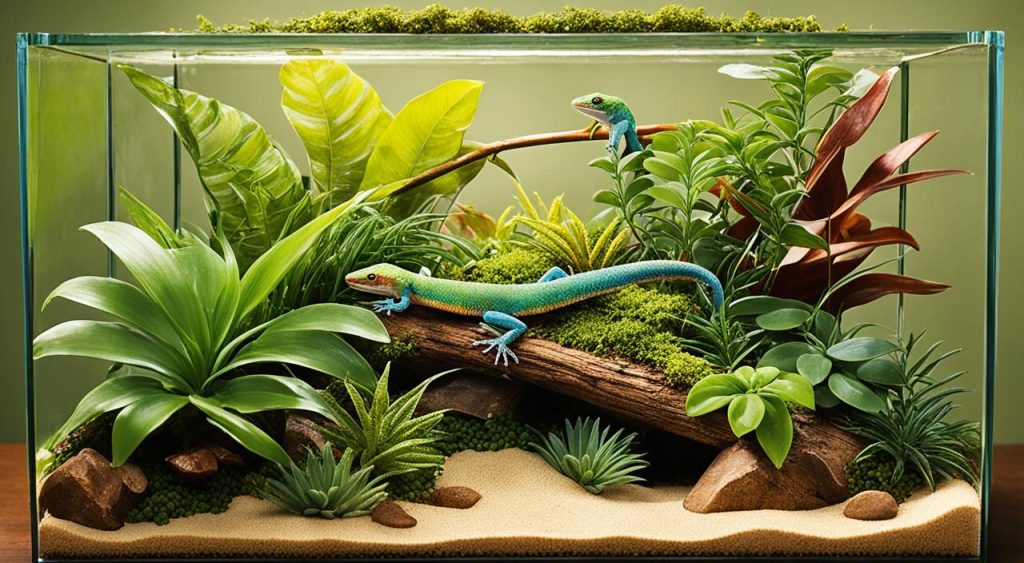
With the right gold dust day gecko habitat and conditions, these arboreal lizards will be happy and healthy.
Feeding the Gold Dust Day Gecko
The gold dust day gecko is a colorful lizard from Hawaii. It loves to eat insects, small invertebrates, soft fruits, and nectar. To keep them healthy in captivity, they need a diet similar to what they eat in the wild.
For pet gold dust day geckos, feed them crickets, mealworms, and waxworms. Dust these insects with calcium and vitamin powder to make sure they get the right nutrients. Sometimes, give them fruits like bananas, mangoes, and papayas as treats.
- Appropriate live food options: Crickets, mealworms, waxworms
- Supplement with powdered calcium and vitamins
- Provide sweet fruits (e.g., bananas, mangoes, papayas) as occasional treats
It’s important to give gold dust day geckos a varied diet. This helps them stay healthy and colorful. By offering different insects and fruits, pet owners can make sure their geckos get everything they need.
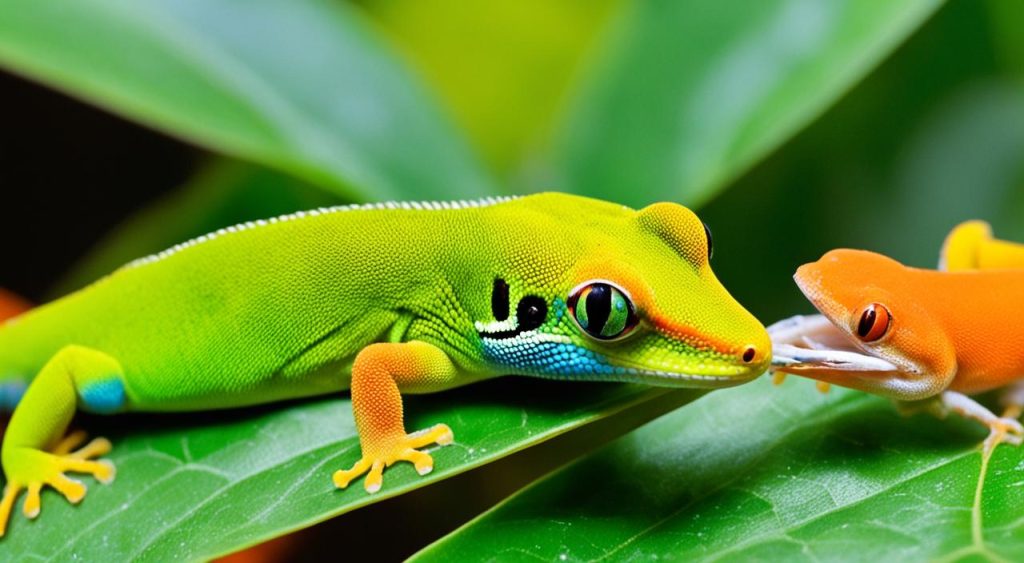
“Maintaining a balanced diet is essential for the gold dust day gecko’s well-being and vibrant appearance.”
Watching how much your gecko eats and changing their diet as needed is key. A nutritious and varied diet helps your gecko grow strong and content in captivity.
Gold Dust Day Gecko: Vibrant Hawaiian Pet Lizard
The gold dust day gecko is a favorite among reptile lovers, especially in Hawaii. These lizards stand out with their bright colors and fun personalities. With the right care, they can live up to 15 years in captivity.
These geckos grow to be about 4.5-6 inches long as adults. Baby geckos are around 1.6 inches long and grow to adult size in a year. They originally come from northwestern Madagascar but are now found in Hawaii too.
Gold dust day geckos love to live in trees and are active during the day. They show off their colors, which include gold, blue, and red. Males will even move their heads from side to side to attract females.
Before getting a gold dust day gecko as a pet, you should know how to take care of them. They need a special environment because they live in trees. With the right care, these beautiful reptiles can be a joy to have as pets.
“Gold dust day geckos are fairly common in the hobby, and their vibrant colors and engaging personalities make them a popular choice among exotic reptile enthusiasts.”
Breeding and Reproduction
The gold dust day gecko (Phelsuma laticauda) is a vibrant reptile from Hawaii. It has a fascinating way of breeding and reproducing. In the wild, these geckos mate and lay eggs, showing their adaptability and resilience.
Mating and Egg-laying
Gold dust day geckos become ready to breed at about 9 months old. It’s best to wait until they are 12 to 14 months old to breed to prevent health problems. To induce breeding, keepers cool the geckos from October to January and warm them up in February.
During breeding season, females can lay 1-2 eggs every three to six weeks. They need the right food and environment to do so. The eggs need to be kept at about 82°F and 60% humidity to hatch in 40-45 days.
Caring for Hatchlings
Caring for the hatchlings of gold dust day geckos is very important. These tiny geckos, about 55-60 mm long, should be kept away from adults. Adults and hatchlings can fight. Keeping the right temperature, humidity, and diet is key for their growth.
With the right care, breeding gold dust day geckos can be rewarding. It lets enthusiasts see the vibrant life cycle of these unique Hawaiian lizards.
“The captive breeding of gold dust day geckos is a fascinating journey, where we can witness the incredible adaptability and resilience of these vibrant Hawaiian lizards.”
Common Health Issues
Gold dust day geckos can face health problems if their care is not right. They might get respiratory infections, skin infections, metabolic bone disease, or parasites. These issues can happen if their needs are not met.
Respiratory issues can cause labored breathing or wheezing. This is often due to the wrong tank temperatures. Skin infections can lead to crusty or discolored skin from dirty living conditions.
Metabolic bone disease happens when they don’t get enough calcium and vitamin D3. This can make their limbs weak and deformed. Internal parasites like pinworms or coccidia can also cause problems. They can come from other sick geckos or dirty food.
These parasites can make geckos lose weight, be very tired, and have stomach issues. Regular vet visits and watching the gecko’s behavior and looks are key. This helps spot health problems early.
Signs that mean a gecko needs a vet include breathing problems, losing weight, and seeing lumps or swelling. By giving the right environment, food, and quick vet care, owners can keep their geckos healthy and happy.
| Common Health Issues | Potential Causes | Signs to Watch For |
|---|---|---|
| Respiratory Infections | Improper tank temperatures | Labored breathing, wheezing |
| Skin Infections | Unsanitary conditions | Crusty or discolored skin |
| Metabolic Bone Disease | Lack of calcium and vitamin D3 | Weakened, deformed limbs |
| Internal Parasites | Contaminated food or environment | Weight loss, lethargy, digestive issues |
Reptile Pets: Why the Gold Dust Day Gecko?
If you’re looking for a vibrant and engaging reptile pet, the gold dust day gecko is a great pick. These lizards from Hawaii are known for their bright looks. They’re a favorite among those who love exotic pets.
One big plus of having a gold dust day gecko is how tough they are compared to some other day geckos. They do well in captivity with the right care. This makes them a good choice for both new and seasoned reptile owners.
These geckos are active during the day, which is different from many other reptiles. This means you can watch and interact with them more easily. They’re also small and live in trees, which is great for people with limited space or who want a unique pet.
| Key Benefits of Owning a Gold Dust Day Gecko |
|---|
| Vibrant and striking appearance Relatively hardy and adaptable to captive care Active during the day for easy observation Compact size and arboreal nature make them suitable for small spaces |
For those looking for an exotic reptile pet that’s both captivating and fun, the gold dust day gecko is a top pick. Its unique looks and easy adaptability to captivity make it a great addition to any reptile collection.
“The gold dust day gecko is a true showstopper, with its vibrant colors and lively personality. As an exotic pet, it’s sure to delight both experienced and novice reptile enthusiasts.”
Bioactive and Naturalistic Enclosures
Many people choose to make bioactive or naturalistic enclosures for gold dust day geckos. These setups have living plants, invertebrates, and microorganisms. They help keep the terrarium’s ecosystem balanced. This makes the geckos’ environment more natural and supports their health.
Creating a live planted terrarium is a great way to house gold dust day geckos. It lets you build habitats that are similar to their natural home in Hawaii. This approach is perfect for those who want to give their geckos a real-life environment.
Adding a variety of live plants helps control the humidity in the enclosure. This creates the perfect conditions for the geckos to flourish. Bioactive setups make the geckos’ space look beautiful. They also help with the geckos’ health and natural behaviors.
FAQ
What is the gold dust day gecko?
The gold dust day gecko (Phelsuma laticauda) is a vibrant, daytime gecko from northern Madagascar, the Comoro Islands, and the Mascarene Islands. It’s a favorite among reptile lovers for its bright green or yellowish green body with red speckles.
Where do gold dust day geckos live in the wild?
Gold dust day geckos live in tropical forests in the wild. They spend most of their time in trees and among the foliage. They are well adapted to life in the treetops.
What are the physical characteristics of the gold dust day gecko?
These geckos can grow up to 3.9-5.1 inches long. They have a bright green or yellowish green body with red speckles. They have a sharp snout, round eyes, sticky feet, a flat tail, and soft skin.
What are the requirements for a gold dust day gecko’s captive habitat?
They need a big terrarium with lots of things to climb on. It should have live plants, vines, and branches to mimic their forest home. They also need UVB lighting, a warm spot, and a humidity level of 40-70%.
What do gold dust day geckos eat in captivity?
In captivity, they eat crickets, mealworms, waxworms, and other insects. They also get powdered calcium and vitamins. Sometimes, they enjoy fruits like bananas, mangoes, and papayas.
How long do gold dust day geckos live?
With the right care, gold dust day geckos can live up to 15 years.
How do gold dust day geckos reproduce?
In the wild, they reproduce by mating and laying eggs. Females lay 1-2 eggs, which hatch after about 40-45 days at 28°C. Baby geckos are small and should be kept alone because they fight a lot.
What are some common health issues in gold dust day geckos?
These geckos can face health problems if not cared for properly. Issues include respiratory infections, skin infections, metabolic bone disease, and parasites. Regular vet visits and watching their health closely are key to spotting problems early.
Why are gold dust day geckos a popular exotic pet?
They are loved for their bright looks, fun behavior, and easy care compared to some other geckos. These geckos are active in the day, making them fun to watch. With the right care, they can do well as pets.
What is a bioactive or naturalistic enclosure for gold dust day geckos?
Some keepers create bioactive or naturalistic enclosures for them. These have living soil, plants, insects, and tiny organisms to keep the terrarium healthy. This setup gives the geckos a more natural home, helping them stay healthy and happy.
